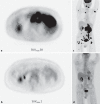[¹⁸F]fluoro-2-deoxy-d-glucose positron emission tomography/computed tomography imaging in oncology: initial staging and evaluation of cancer therapy
- PMID: 23363934
- PMCID: PMC5586772
- DOI: 10.1159/000346303
[¹⁸F]fluoro-2-deoxy-d-glucose positron emission tomography/computed tomography imaging in oncology: initial staging and evaluation of cancer therapy
Abstract
Positron emission tomography (PET) with [¹⁸F]fluoro-2-deoxy-D-glucose (FDG) has proven to be a valuable diagnostic modality in various diseases. Its accuracy has been improved with the hybrid PET/computed tomography (CT) technique because of precise anatomic location of areas of abnormal FDG accumulation. This integrated PET/CT modality has been widely adopted, particularly in oncology. This paper reviews the role of FDG-PET/CT imaging in breast cancer, non-small-cell lung cancer, colorectal cancer, head and neck cancer as well as lymphoma on the basis of recent key articles. Special attention is paid to preoperative diagnostic workup, evaluation of treatment response and survival prognosis. Experience from specialized centers indicates that there is strong evidence for the clinical effectiveness of FDG-PET/CT in staging, restaging and the prediction of response to therapy in the above-mentioned malignancies. It is concluded that this imaging modality contributes considerably to improved patient management and paves the way to personalize cancer treatment in a cost-effective way.
Copyright © 2013 S. Karger AG, Basel.
Figures


Similar articles
-
Present and future role of FDG-PET/CT imaging in the management of head and neck carcinoma.Jpn J Radiol. 2015 Dec;33(12):776-89. doi: 10.1007/s11604-015-0495-1. Epub 2015 Oct 27. Jpn J Radiol. 2015. PMID: 26507982 Review.
-
Can 3'-Deoxy-3'-((18)F) Fluorothymidine Out Perform 2-Deoxy-2-((18)F) Fluoro-D-Glucose Positron Emission Tomography/Computed Tomography in the Diagnosis of Cervical Lymphadenopathy in Patients With Oral/Head and Neck Cancer?J Oral Maxillofac Surg. 2015 Jul;73(7):1420-8. doi: 10.1016/j.joms.2015.01.002. Epub 2015 Jan 13. J Oral Maxillofac Surg. 2015. PMID: 25869746
-
FDG PET Hybrid Imaging.Recent Results Cancer Res. 2020;216:625-667. doi: 10.1007/978-3-030-42618-7_19. Recent Results Cancer Res. 2020. PMID: 32594401 Review.
-
Utility of Molecular Imaging with 2-Deoxy-2-[Fluorine-18] Fluoro-DGlucose Positron Emission Tomography (18F-FDG PET) for Small Cell Lung Cancer (SCLC): A Radiation Oncology Perspective.Curr Radiopharm. 2019;12(1):4-10. doi: 10.2174/1874471012666181120162434. Curr Radiopharm. 2019. PMID: 30465520 Review.
-
FDG PET and PET/CT.Recent Results Cancer Res. 2013;187:351-69. doi: 10.1007/978-3-642-10853-2_12. Recent Results Cancer Res. 2013. PMID: 23179888 Review.
Cited by
-
Integrated ¹⁸F-FDG PET/perfusion CT for the monitoring of neoadjuvant chemoradiotherapy in rectal carcinoma: correlation with histopathology.Eur J Nucl Med Mol Imaging. 2014 Aug;41(8):1563-73. doi: 10.1007/s00259-014-2752-4. Epub 2014 Apr 24. Eur J Nucl Med Mol Imaging. 2014. PMID: 24760269
-
Positron Emission Tomography (PET) in Oncology.Cancers (Basel). 2014 Sep 29;6(4):1821-89. doi: 10.3390/cancers6041821. Cancers (Basel). 2014. PMID: 25268160 Free PMC article. Review.
-
Real time dynamic imaging and current targeted therapies in the war on cancer: a new paradigm.Theranostics. 2013 May 25;3(6):437-47. doi: 10.7150/thno.5658. Print 2013. Theranostics. 2013. PMID: 23781290 Free PMC article. Review.
-
Importance of Anatomical Variation of the Hepatic Artery for Complicated Liver and Pancreatic Surgeries: A Review Emphasizing Origin and Branching.Diagnostics (Basel). 2023 Mar 24;13(7):1233. doi: 10.3390/diagnostics13071233. Diagnostics (Basel). 2023. PMID: 37046451 Free PMC article. Review.
-
Colorectal cancer: Parametric evaluation of morphological, functional and molecular tomographic imaging.World J Gastroenterol. 2019 Sep 21;25(35):5233-5256. doi: 10.3748/wjg.v25.i35.5233. World J Gastroenterol. 2019. PMID: 31558870 Free PMC article. Review.
References
-
- Czernin J, Benz MR, Allen-Auerbach MS. PET/CT imaging: the incremental value of assessing the glucose metabolic phenotype and the structure of cancers in a single examination. Eur J Radiol. 2010;73:470–480. - PubMed
-
- Keyes JW., Jr SUV: standard uptake or silly useless value? J Nucl Med. 1995;36:1836–1839. - PubMed
-
- Miller AB, Hoogstraten B, Staquet M, et al. Reporting results of cancer treatment. Cancer. 1981;47:207–214. - PubMed
-
- Eisenhauer EA, Therasse P, Bogaerts J, et al. New response evaluation criteria in solid tumours: revised RECIST guideline (version 1.1) Eur J Cancer. 2009;45:228–247. - PubMed
Publication types
MeSH terms
Substances
LinkOut - more resources
Full Text Sources
Other Literature Sources

